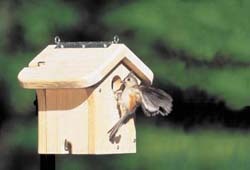 Fun Facts About Tufted Titmice
Fun Facts About Tufted Titmice
Though the large, dark, fluid black eyes of titmice seem to be their defining characteristic, these birds exhibit a number of behaviors that make them unique.
- Tufted Titmice have an alarm call that seems to fade off into the distance, giving the impression that the bird is moving from one place to another. Birdwatchers and predators alike can be fooled into chasing this ghost call while the titmouse stays securely hidden out of sight.
- Tufted Titmice are one of just a few perching birds that can use their feet to hold seeds while they break them open.
- During the winter, Tufted Titmice forage together with chickadees, nuthatches, woodpeckers and Brown Creepers.
- The Tufted Titmouse has been expanding its range northward since the 1940s and is now found almost to the Canadian border across most of its range. Speculation for the expansion suggests warming winter temperatures and the increase in mature woodland habitat.
- Tufted Titmice have been known to wander northward in the fall and winter, even into southern Canada.
- On rare occasions, a young Tufted Titmouse will stay with its parents into the next nesting season and help its parents raise the next brood.
- The Tufted Titmouse and the Black-crested Titmouse were re-classified into just one species in 1983. The Black-crested Titmouse frequents mesquite shrub habitat and the Tufted Titmouse favors broadleaf hardwood forests.
- Tufted Titmice will regularly eat snow when water for drinking is not available.
- Tufted Titmice do not excavate their own nesting cavity. Instead they use natural holes in trees and abandoned cavities excavated by woodpeckers. They will also use artificial nesting boxes.
- The Bridled Titmouse, unlike the other titmice species, does not hide seeds for future use. The part of the brain used to store memories of hiding places is small in this species compared with other species that frequently hide food.
- The Oak Titmouse mates for life, and together they defend a territory throughout the year.
- The incubating female of the Juniper Titmouse sits very tight on her nest and will hiss like a snake if disturbed.

